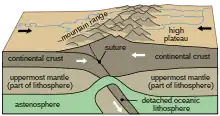Granitoid
A granitoid is a generic term for a diverse category of coarse-grained igneous rocks that consist predominantly of quartz, plagioclase, and alkali feldspar.[1] Granitoids range from plagioclase-rich tonalites to alkali-rich syenites and from quartz-poor monzonites to quartz-rich quartzolites.[2] As only two of the three defining mineral groups (quartz, plagioclase, and alkali feldspar) need to be present for the rock to be called a granitoid, foid-bearing rocks, which predominantly contain feldspars but no quartz, are also granitoids.[2] The terms granite and granitic rock are often used interchangeably for granitoids; however, granite is just one particular type of granitoid.

Granitoids are diverse; no classification system for granitoids can give a complete and unique characterization of the origin, compositional evolution, and geodynamic environment for the genesis of a granitoid. Accordingly, multiple granitoid classification systems have been developed such as those based on: geochemistry, modal content, emplacement depth, and tectonic regime.
Granitoid generalizations

There are several generalizations that apply to majority of granitoids. Typically, granitoids occur where orogeny thickens continental crust either by subduction yielding a continental arc or by convergence yielding continental collisions.[3] Generally, the evolution to granitoid magmas requires a thermal disturbance to ascent though continental crust.[3] Most granitoids are generated from crustal anatexis, the partial melting of the crust; however the mantle may contribute both heat and material.[3] Granitoids can occur coeval with volcanic rocks that have equivalent chemical composition ( granites-rhyolites, syenite-trachyte, dacite-granodiorite etc.) however, these extrusive rocks are often eroded so just the plutonic rocks outcrop.[3] Granitoids can form in all tectonic environments.[3]
There are numerous exceptions to these generalizations.[4][3] For example, granitoids can form in anorogenic environments, a granitoid source rock can be from the mantle (ex. intraplate hotspots) and the melting mechanism can be radiogenic crustal heat.[4][5][6]
References
- "USGS: Mineral Resources On-Line Spatial Data: Granitoid".
- Streckeisen, A. (1974). "Classification and Nomenclature of Plutonic Rocks: Recommendations of the IUGS Subcommission on the Systematics of Igneous Rocks". Geologische Rundschau (in German). 63 (2): 773–86. Bibcode:1974GeoRu..63..773S. doi:10.1007/BF01820841. S2CID 130569261.
- Winter, John D. (2014). Principles of igneous and metamorphic petrology. Harlow. p. 402. ISBN 978-1-292-02153-9. OCLC 890442947.
{{cite book}}: CS1 maint: location missing publisher (link). - Clarke, D. B. (1992) Granitoid Rocks, Chapman & Hall, London.
- Pitcher, W. S. 1982. Granite type and tectonic environment. In Hsu, K. J. (ed.) Mountain Building Processes, 19–40. London: Academic Press.
- Barbarin, Bernard (1990). "Granitoids: Main petrogenetic classifications in relation to origin and tectonic setting". Geological Journal. Wiley. 25 (3–4): 227–238. doi:10.1002/gj.3350250306. ISSN 0072-1050.